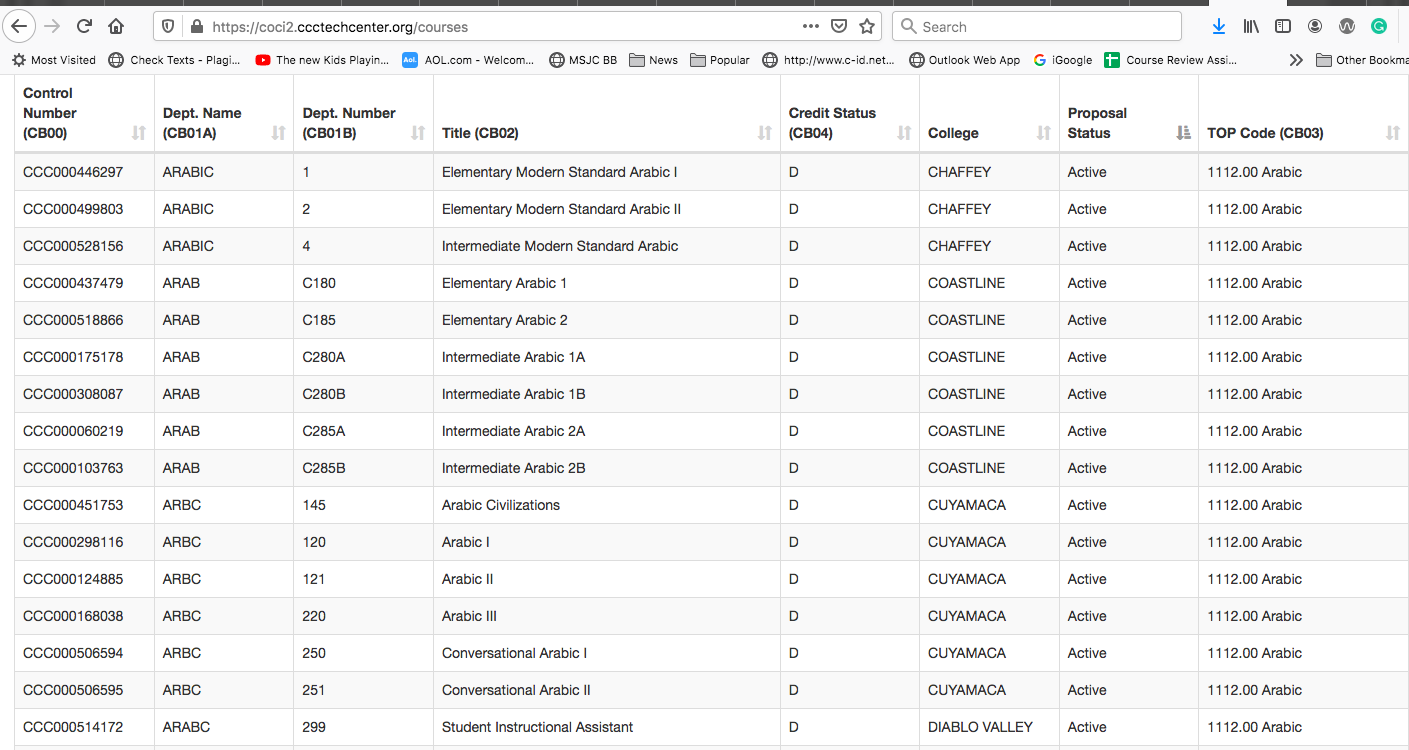Not C-ID, no TMC. Major preparation? General Education?
Where to start?
The Chancellor’s Office Curriculum Inventory System (COCI)?
In order to search COCI, you need to have a meaningful search parameter. If you look at Programs in COCI, you can search by any of the following (screenshot follows for illustration):
- College
- Goal
- TOP Code
- Status
- Award

In order to search COCI, you need to have a meaningful search parameter. If you look at Courses in COCI, you have the same search parameters that you had for Programs (college, goal, TOP Code, Status, Award) and the following (screenshot follows for illustration):
- Credit Status (CB04)
- SAM Priority Code (CB09)
- Work Experience (CB10)
- Proposal Status
- Proposal Status
- Noncredit (CB22)
- Basic Skills (CB08)
- Transfer Status (CB05)

What do we need to know in order to effectively make the case for a resource that serves the indicated course?
What colleges have an Arabic program or Arabic courses? In order to establish this, we need to know the TOP Code for such programs and courses.
Scanning the TOP Codes in COCI is very unlikely to be fruitful – they are not organized in a meaningful manner – as the screenshot below demonstrates. While similar programs are listed near one another, they are not in alphabetical order.

In order to find the T.O.P. Code you are interested in, you will want to go to the actual Taxonomy of Program Codes. This document is a PDF that can be searched. If we search it for “Arabic”, we quickly find what we need: 1112.00 – Arabic language, literature, and culture of Arabic-speaking people.
Returning to COCI, we can identify what colleges have programs in this TOP Code. Unfortunately, this yields just 6 programs (certificates or degrees), four of which are in one district. While we would no anticipate that Arabic courses would be found more broadly, we can conduct a search in COCI by courses in order to ensure that we are not missing any data. While courses that are not part of an existing program should generally be less common, if they fill a general education requirement they may be more available than one would anticipate. And that is the case here – 186 courses are found under the T.O.P. Code. After limiting the results to those that are “Active” (“Proposal Status”), our number drops to 104. The next step would be to download the data as an Excel file to determine which colleges appear to have a comparable course based on the indicated title. The screenshot below shows that the COCI data would allow the user to identify which colleges are likely to have a course comparable to a first-term Arabic language course.

Is there a way to actually determine how many students take such a course? This is where you would likely turn to “Datamart”. The California Community Colleges Chancellor’s Office – Data Mart allows the user to obtain a wide array of data. Most importantly for our purposes are the Credit Courses/Sections and Non-Credit Courses/Sections data. Credit Courses/Sections provides count of sections, enrollments, and Fulltime Equivalent Students (FTES) by credit status, T.O.P. code, accounting method, SAM code, and day/evening status. Using our example, use the Course Details option to get a list of courses offered in a term with count of sections, TOP code, and other course characteristics. These data must be pulled by term, so you would need to view data for a number of sample terms to get a clear sense of the number of sections that are generally offered.

